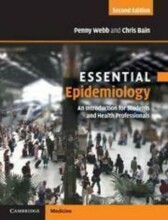Summary: Hnh24806
- This + 400k other summaries
- A unique study and practice tool
- Never study anything twice again
- Get the grades you hope for
- 100% sure, 100% understanding
Read the summary and the most important questions on HNH24806
-
E-modules on prevalence, incidence and standardisation
This is a preview. There are 23 more flashcards available for chapter 04/09/2019
Show more cards here -
What does a/how things a clinician?
He translates scientific knowledge and procedures to: "What is the best treatment for this specific patient?" -
What does a/How things an epidemiologist in academic setting?
"How can I be sure about this specific exposure-effect, independent of the context of this person or population" -
Incidence in closed population + what is a closed population
Measure of disease occurrence:- incidence proportion (IP)
- incidence rate (IR)
closed population- bases ons fixed membership
- no one can be added
- but people may die, lost to follow-up etc
- becomes smaller in time
- everyone is followed
-
Incidence in open population + what is a open population
Measure of disease occurrence:- incidence rate (IR)
open cohort or dynamic population- can take new members with time
- people move in and out of the area
- number remain about the same
- no follow-up when leaving
-
Relationship between incidence, prevalence and duration
Zie de afbeelding -
C2 public health & its study designs
This is a preview. There are 11 more flashcards available for chapter 09/09/2019
Show more cards here -
When you call it a risk you are looking at...
Incidence proportion/Cumulative incidence -
When do you use direct standardisation? And when indirect standardisation?
direct:- To compare rates across different countries
- to compare rates between different subgroups within one country
indirect:- Same, but especially used when subgroups are small and the age-specific rates are not very reliable or unknown
- To compare rates across different countries
-
L1 pulmonary diseases (longziektes)
This is a preview. There are 6 more flashcards available for chapter 10/09/2019
Show more cards here -
What are the risk factors for COPD
Environmental risk factors- smokers
- (roken tijdens zwangerschap)
- mee roken (mensen die in je omgeving roken)
- outdoor air pollution + indoor air pollution
- blootstelling tijdens het werken
genetic susceptibility
ageing -
E-modules + assignment cancer
This is a preview. There are 13 more flashcards available for chapter 11/09/2019
Show more cards here -
What is health? (Uitspraken)
- Absence of illness
- a state of complete physical, mental and social well-being (1948)
- ability to adapt and self manage in the face of social, physical, and emotional challenger (2011)
Health is weighed by personal values and preferences, and group characteristics (age, gender, culture) - Absence of illness
-
What are the organised efforts of society?
- Governmental organizations
- non-governmental organizations
acting on:
- local, regional, national or international level - Governmental organizations
- Higher grades + faster learning
- Never study anything twice
- 100% sure, 100% understanding































